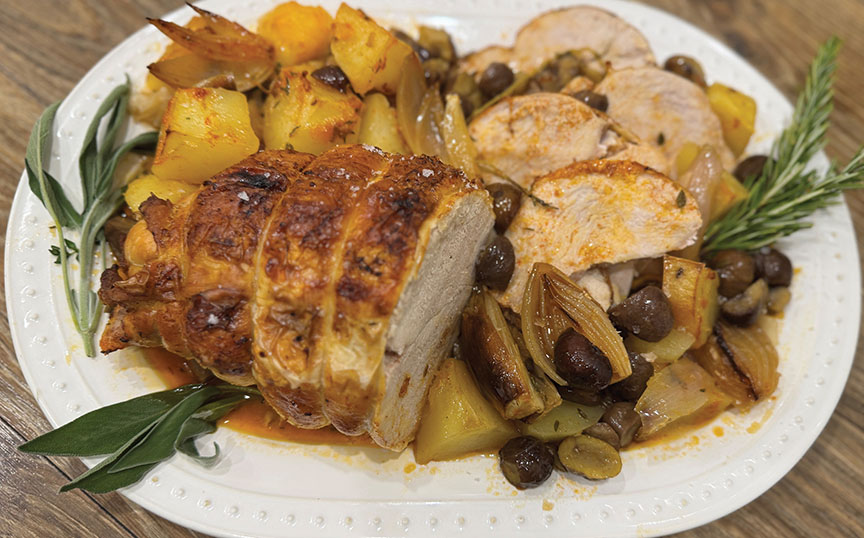
Ambrosia is the food of the gods; we mere mortals are blessed with the sweet richness of baklava. The transcendent delights of a single bite include thin, flaky phyllo pastry layered with crushed almonds and walnuts delicately spiced with cinnamon and cardamom, doused in a rose water and lemon juice infused honey syrup.
In the eighth century B.C.E., the ancient Assyrians began to layer unleavened dough with nuts and poured honey over it. In the second century, the Romans baked a cheese, honey and dough dessert with the rather unappetizing name “placenta.” The rise of the Byzantine Empire brought this dessert east to the region of Turkey and Greece.
Although the Greeks and Turks argue over who can lay claim to the origins of baklava, two facts remain undisputed. The Greeks invented the ultra-thin dough used to make baklava; phyllo means leaf in Greek. The name has Turkish origins and the baklava we know and love comes from the sultan’s kitchen in the Topkapi Palace in Istanbul. On the 15th day of Ramadan, the sultan would express his appreciation to the Janissaries, his elite army, by presenting them with trays of baklava in a special procession called the Baklava Alayi.
Baklava, in its many variations, is common to the cuisines of all the countries of the former Ottoman Empire — the Middle East and the Balkans, as well as Greece, Persia, the Maghreb and Algeria.

Three monotheistic faiths include baklava in their religious observance. Muslims indulge in baklava to break the fast of Ramadan. Christians bake baklava for Lent — some use 40 layers of phyllo to represent the 40 days of Lent (the observance between Ash Wednesday and Easter during which many adherents pray, do penance and fast); others use 33 to represent the years of the life of Jesus. Sephardic Jews serve baklava on Rosh Hashanah and Purim.
After marrying into a Rhodesli family, Rachel learned to make baklava using the Tia Naomi’s recipe. Just like an ancient Greek recipe found on the island of Crete, the Sheff family recipe includes sesame seeds. My Iraqi grandmother made an exquisitely light, sweet and crispy baklava for every family celebration. Baking baklava always loomed as an intimidating feat, but the memory of my grandmother’s baklava (and Rachel’s encouragement and this story) made me tackle the challenge. I discovered that baking baklava requires patient assembling and delicate handling of the fragile dough.
The honey syrup that is poured over the dessert after baking can be flavored with any combination of lemon juice, rose water and orange blossom essence. Experimenting in the kitchen, Rachel and I discovered that reducing the amount of syrup makes the final product less cloying. Have fun mixing and matching the ground nuts you use — almonds, walnuts and pistachios all taste delicious.

Tia Naomi’s Rolled Baklava
Filling:
2 cups almonds
3 cups pecans
1 cup sugar
1 cup toasted sesame seeds
2 teaspoons cinnamon
Dough:
1 box phyllo dough
1 cup oil (vegetable, canola, safflower, avocado)
Syrup:
1 cup honey
1 cup sugar
1 cup water
Preheat oven to 350 F.
In food processor, chop almonds and pecans.
In large bowl, combine nuts, sugar, sesame seeds and cinnamon.
Unfold phyllo dough and cover with damp kitchen towel to prevent it from drying out. (If it starts to dry out, sheets will break.)
Place one phyllo sheet on flat surface and lightly brush with oil. Layer another sheet on top and brush with oil and sprinkle with about 3 tablespoons of filling. Layer third sheet on top, brush with oil and sprinkle with about 3 tablespoons of filling (keep phyllo sheets under damp towel).
Working from the bottom up, carefully roll phyllo into a tight roll, then place on greased cookie sheet. Repeat this process until all dough is used or cookie sheet is full.
Slice rolls into 1- to 2-inch pieces.
Bake 25 minutes until golden.
While pastry is baking, combine honey, sugar and water in pan. Boil until mixture becomes sticky and a beautiful golden color.
Remove pastry from oven, let cool for 15 minutes and pour cooled syrup over pastry. Sprinkle with sesame seeds.
This baklava can be frozen, without the syrup. Defrost and then top with syrup when ready to serve.
Nana Aziza’s Baklava
Syrup:
1 cup sugar
1 cup honey
3/4 cup water
3 tablespoons lemon juice
2 tablespoons rosewater
Filling:
3/4 pound ground almonds
3/4 pound ground walnuts
2 tablespoons sugar
2 tablespoons ground cardamom
1 tablespoon cinnamon
2 tablespoons rosewater
Dough:
1 pound package phyllo dough
1 cup almond oil or expeller pressed canola oil
Combine sugar, honey, water, lemon juice and rosewater in small pot and simmer over low heat to dissolve sugar.
Stir well and simmer until liquid thickens into a syrup.
Set aside to cool.
Preheat oven to 350 F.
In large bowl, mix ground almonds, ground walnuts, sugar, spices and rosewater.
Lightly grease baking tray.
Separate phyllo sheets. Place one sheet on top of another on tray, lightly brushing every second sheet with oil. Repeat.
After sixth sheet, spread about 4 tablespoons of nut mixture over phyllo.
Layer another four sheets, brushing every second sheet with oil.
Spread rest of nut mixture on top and cover with six sheets of phyllo, brushing every second sheet with oil.
With a very sharp wet knife, cut five equidistant lines into pastry, then cut diagonally to create small diamonds.
Brush remaining oil over pastry.
Bake for 35 minutes or until golden brown.
Remove from oven and pour cooled syrup over baklava.
Rachel Sheff’s family roots are Spanish Moroccan. Sharon Gomperts’ family hails from Baghdad and El Azair in Iraq. Known as the Sephardic Spice Girls, they have collaborated on the Sephardic Educational Center’s projects and community cooking classes. Join them on Instagram at SephardicSpiceGirls, or on Facebook group SEC food.


































